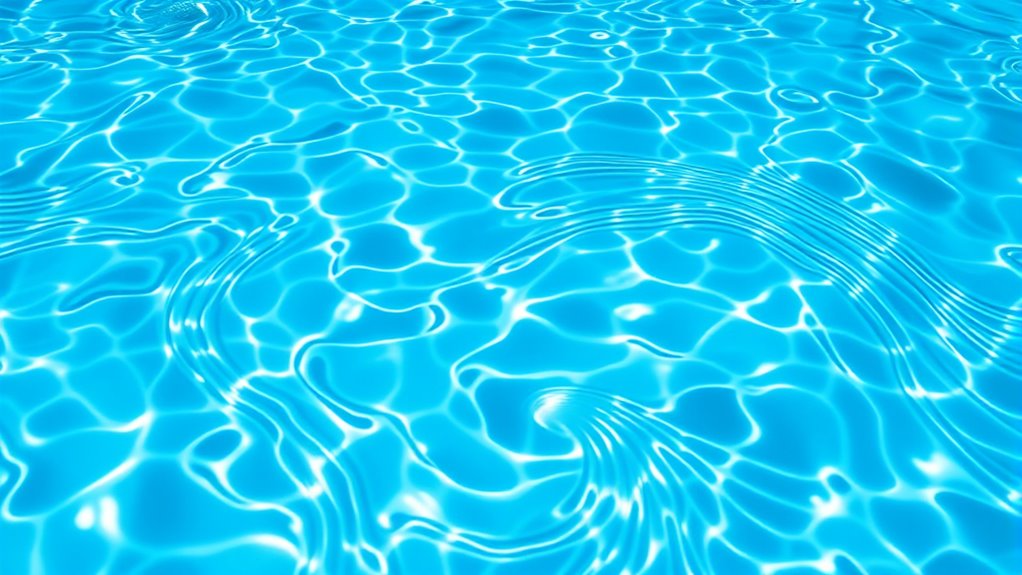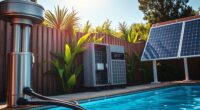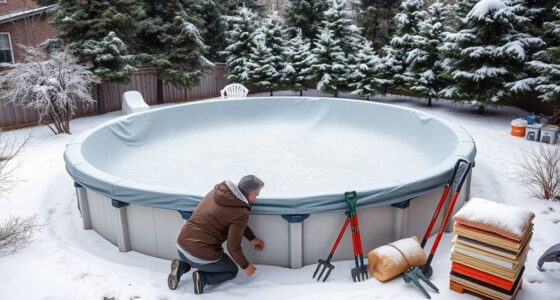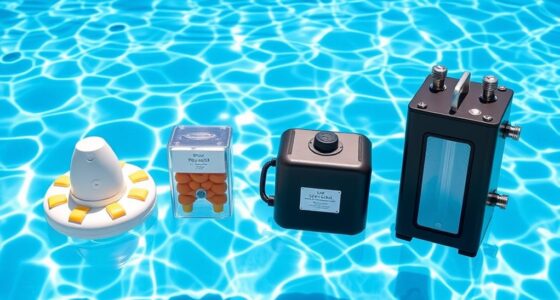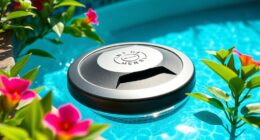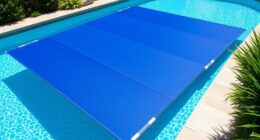Understanding pool circulation and hydraulics helps you keep your water clean, safe, and efficient. Proper system design guarantees water moves smoothly through pumps, pipes, and valves, preventing dead zones and ensuring proper filtration and chemical balance. Choosing efficient pumps and correctly sizing pipes reduce energy use and improve flow. Good layout minimizes turbulence and blockages, keeping the water healthy and inviting. Keep exploring, and you’ll discover how to optimize every part of your pool’s hydraulic system.
Key Takeaways
- Proper pool circulation involves pumps, pipes, and valves working together to keep water moving smoothly.
- Correct pump selection and efficiency prevent high energy costs and ensure strong water flow.
- Proper pipe sizing reduces resistance, maintains optimal flow, and enhances filtration performance.
- System design minimizes sharp turns and obstructions, reducing turbulence and pressure drops.
- Regular maintenance and correct layout promote even circulation, chemical distribution, and overall water quality.
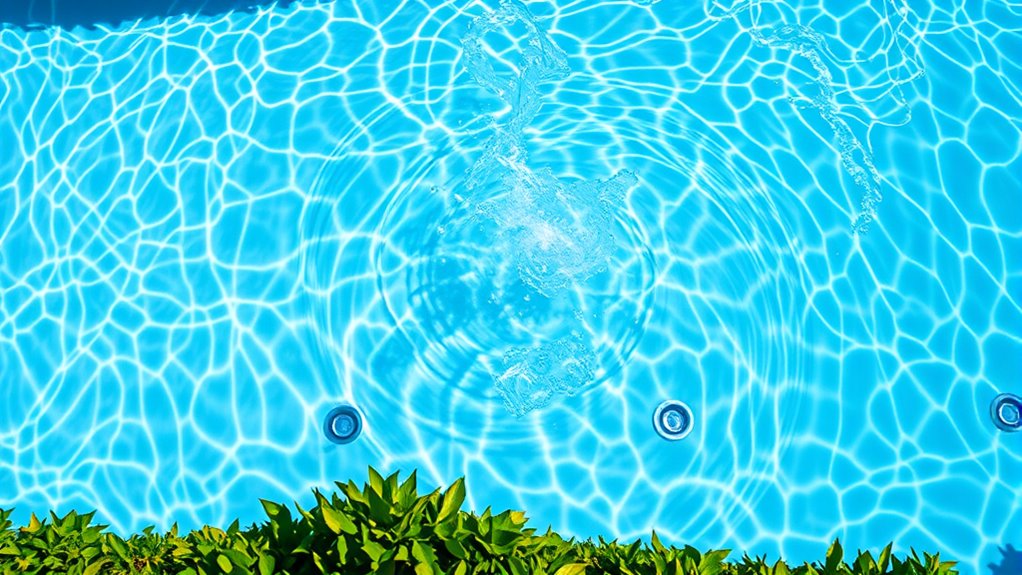
Effective pool circulation and hydraulics guarantee clean, safe, and inviting water. When you understand how your pool’s circulation system works, you can guarantee it runs efficiently, saving you energy and maintenance costs. At the core of this system are components like pumps, pipes, and valves, all working together to keep water moving smoothly. One of the key factors influencing the system’s performance is pump efficiency. A high-efficiency pump uses less energy while maintaining strong water flow, which means your pool stays clean without skyrocketing your electricity bill. Choosing the right pump size and type guarantees ideal flow rates, preventing issues like dead zones or inadequate filtration.
Beyond pump efficiency, pipe sizing plays a critical role in maintaining effective hydraulics. If the pipes are too narrow, they create excessive resistance, slowing water flow and forcing your pump to work harder. This not only wastes energy but also can lead to equipment wear and tear over time. Conversely, pipes that are too large may reduce flow velocity, which can impair proper filtration and skimming. Proper pipe sizing balances these factors, ensuring water moves at the right velocity for effective cleaning and filtration. When sizing pipes, you need to take into account factors like pool size, pump capacity, and the number of fittings or turns in the plumbing system. Properly designed pipework minimizes friction losses and promotes even water circulation, which is essential for maintaining water clarity and chemical balance.
It’s also important to understand that pipe layout impacts hydraulics. A well-designed system minimizes sharp turns and obstructions, reducing turbulence and pressure drops. This allows your pump to operate more efficiently and ensures water reaches all areas of your pool consistently. Regular inspections of pipes and fittings help identify leaks or blockages that can disrupt circulation, so you can address issues before they affect water quality. Additionally, balancing flow rates between supply and return lines ensures even distribution of chemicals and heat, creating a more consistent swimming environment.
Frequently Asked Questions
How Often Should I Adjust My Pool’s Circulation System?
You should adjust your pool’s circulation system at least once a month to maintain ideal filter maintenance and pump efficiency. Regular checks ensure the water flows properly, preventing debris buildup and ensuring the filter isn’t overworked. If you notice cloudy water or reduced flow, increase adjustments. Consistent upkeep keeps your pool clean, saves energy, and prolongs your equipment’s lifespan, so don’t skip these routine checks.
Can Poor Circulation Cause Algae Growth?
Poor circulation can definitely cause algae proliferation because circulation inefficiency prevents proper distribution of sanitizers and chemicals. When water isn’t circulating well, nutrients and algae spores settle and grow, leading to cloudy water and algae buildup. To prevent this, verify your circulation system operates efficiently, run your pump regularly, and check for blockages. Good circulation keeps chemicals evenly distributed, reducing the chances of algae growth and maintaining a clean, healthy pool.
What Are Signs of Inadequate Hydraulic Flow?
You’ll notice signs of inadequate hydraulic flow through flow disruptions and water stagnation. If your pool water isn’t circulating properly, you might see dead spots, algae buildup, or cloudy water. Reduced flow can cause uneven chemical distribution and debris accumulation. Keep an eye on your pump’s performance, ensure valves are open fully, and check for blockages to prevent flow disruptions and water stagnation, guaranteeing a healthy, clear pool.
How Does Temperature Affect Pool Hydraulics?
Temperature dramatically impacts your pool’s hydraulics, making it feel like a rollercoaster ride! As water warms, thermal stratification occurs, causing layers that hinder flow and reduce pump efficiency. You might notice sluggish circulation or cloudy water. Cooler temperatures improve flow, but excessive heat can strain your pump and disrupt circulation. Monitoring water temperature helps optimize hydraulics, ensuring your pool stays crystal clear and well-circulated, no matter the season.
Is Professional Maintenance Necessary for Complex Systems?
Yes, professional maintenance is essential for complex systems. You need experts to guarantee proper chemical balancing, which keeps your water safe and clear. They also handle equipment upgrades, improving efficiency and preventing costly breakdowns. Regular professional checkups catch issues early, maintaining ideal circulation and hydraulics. Don’t underestimate the importance of skilled maintenance; it keeps your pool running smoothly, saving you time, money, and hassle in the long run.
Conclusion
By mastering pool circulation and hydraulics, you control the heartbeat of your pool, ensuring crystal-clear water and a pristine swimming experience. When you optimize your system, it’s as if you wield the power to tame a wild river, transforming chaos into calm. Remember, proper circulation isn’t just technical—it’s the magic that keeps your pool sparkling like a jewel in the sun’s glow. Take charge, and your pool will thank you with endless, shimmering perfection.
